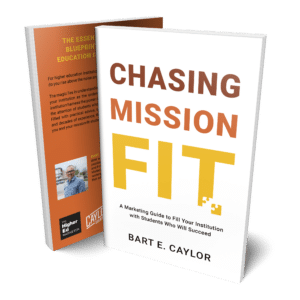Marketing to the Entire Student Life Cycle
Effective marketing thinks long-term, crafting messaging for the entire student life cycle. To do that, you’ll need everyone on board.
Featured
Overcoming fear of AI in marketing is essential for higher ed professionals adapting to the rapid changes of generative AI.
There’s a natural tendency to resist change, especially when it disrupts our confidence in how things are done.
AI is evolving rapidly, and while we might feel the pressure to “figure it all out” before engaging, the truth is, we don’t need all the answers right away.
What we do need is a shift from fear to curiosity.
It’s easy to be apprehensive about AI. We see headlines about job automation, ethical concerns, and even misinformation risks.
Many marketing professionals worry:
These fears are valid.
That is partly why I continue to write about generative AI tools on my blog.
I want to help higher ed marketers understand and leverage AI so that they improve their enrollment results with even more mission-fit students.
But even with helpful blogs, trainings, and other resources, they can only do so much if we have a fear mentality, which can be severely limiting.
Fear itself isn’t the problem.
Having concerns, asking critical questions, and acknowledging risks are all healthy reactions to change.
That’s just being responsible.
A fear mentality, however, is when we let those concerns prevent us from taking action.
It’s when we assume the worst and make decisions based on avoidance rather than engagement.
A fear mentality keeps us stuck—reluctant to experiment, unwilling to take risks, and too focused on potential downsides to see the opportunities.
It keeps us in survival mode instead of growth mode.
But when we shift from fear to curiosity, we allow ourselves to explore, adapt, and ultimately lead the way in how AI can be leveraged in higher ed marketing.
Instead of letting fear dictate how we interact with AI, let’s take a step back and ask: What if I explored this with curiosity?
Curiosity opens doors to experimentation.
It allows us to approach AI not as an all-knowing replacement but as a creative collaborator.
Generative AI is a tool—not a threat.
Like any tool, its value depends on how we use it.
Imagine AI as an eager intern on your team.
Interns don’t walk in on day one ready to replace anyone; they need guidance, mentorship, and iteration.
The same applies to AI.
Waiting until there’s a crisis to figure out AI is a surefire way to invite stress. Instead, set aside time to play. Open up ChatGPT or another AI tool and test it with low-risk, creative prompts.
Approach it like a brainstorming session, not a final product. This practice builds familiarity and confidence.
Language shapes mindset. Instead of saying, “AI is going to change everything, and I don’t know how to keep up,” try:
Simply changing how we talk about AI reframes it from something to fear into something to explore.
Fear isolates; curiosity connects. Instead of feeling pressure to “master” AI alone, involve colleagues. Designate a small team or working group to test AI tools together.
When AI becomes a collective learning experience, the fear factor drops significantly.
AI isn’t here to replace strategic thinking—it’s here to enhance it. Instead of handing over full control, think about co-creation.
AI is a powerful assistant, but your expertise is still the driver.
One of the biggest misconceptions about AI is that it’s a “robot”—a machine designed to take over tasks, replacing human effort.
But that’s not the best way to think about it.
Instead, AI should be viewed as a “co-bot,” a collaborative assistant that works alongside us rather than instead of us.
A co-bot enhances your abilities, amplifies creativity, and streamlines repetitive processes so that you can focus on higher-level strategy and meaningful engagement.
When used correctly, AI doesn’t replace expertise—it augments it.
Just like a great team member, AI is most effective when given the right prompts, guidance, and refinement.
The best results come from marketers who are willing to collaborate with AI rather than resist it.
Curiosity allows for iteration. AI tools will continue evolving, and the best approach is to learn as you go.
Start small, build confidence, and allow your experience to shape how you integrate AI into your marketing efforts.
The best way to navigate the rapid changes in higher ed marketing isn’t by avoiding new technology—it’s by engaging with it.
AI isn’t something to fear; it’s something to explore.
Instead of worrying about what AI might do, start asking what it could do.
Shifting from fear to curiosity opens new opportunities, strengthens innovation, and allows for meaningful experimentation.
The more we explore AI’s potential, the more we can shape it into a tool that supports and enhances our work.
Elevate Your Content Strategy with AI-Driven Insights
At Caylor Solutions, we help higher ed marketers create and distribute valuable, relevant, and consistent content to attract and retain a clearly defined audience.
Our Content Strategy and Marketing services ensure that your messaging aligns with your institutional goals while leveraging cutting-edge tools like AI to enhance engagement and efficiency.
Whether you’re looking to refine your content strategy, increase audience engagement, or develop an AI-enhanced workflow, we’re here to help.
Let’s work together to turn curiosity into impactful storytelling and meaningful connections.
The essential marketing book every higher education institution needs! If you are a higher education marketing professional seeking a fail-safe plan to make your institution stand out, “Chasing Mission Fit” is your guide.

So you can empower your institution with audience-focused marketing strategies, and attract mission-fit students who will flourish in your unique academic environment.
Ready to transform your institution’s marketing approach?
Order now!
Images via Midjourney
Subscribe to The Higher Ed Marketer podcast today!